Twin Lakes Fact Page
Twin Lakes are located about 8.5 miles west of
Inchelium, Washington on the Colville
Confederated Tribes Reservation. In 2004 and
2005, Washington State University and the tribe
conducted a study to determine prey selectivity
and population dynamics of the Twin Lake fish
community. The primary goal was to determine if
largemouth bass were controlling golden shiners
through predation and if that predator-prey
relationship could be enhanced. Another
objective was to determine if trout growth and
condition are being compromised by the presence
of golden shiners.
The data suggests that bass are predating
extensively on golden shiners and are a key
factor in controlling shiner populations. Trout
growth rates and condition are relatively good
despite the presence of golden shiners. This
may be due to the presence of bass predating on
shiners and preventing their population from
reaching a point in which the trout community
would be affected.
The information contained below is a brief
results summary from the sampling conducted in
2004 and 2005. After data was collected all
fish were released back into the lakes.

Twin Lakes, Washington
Twin Lake Physical
Properties
Surface acres: North Twin Lake
= 917 acres, South Twin Lake = 1,020 acres.
Max depth: North Twin Lake =
50ft, South Twin Lake = 57ft.
Mean depth: North Twin Lake =
32ft, South Twin Lake = 34ft.
Trophic state: Mesotrophic
(mesotrophic means the lakes are in an
intermediate productivity level. There is a
natural aging process in which sediment,
organic, and nutrient inputs cause a lake to
age and become nutrient rich (eutrophic). Poor
land management practices can enhance and
accelerrate this natural aging process. The
trophic staus of a lake often dictates what
type of fish species can live in it).
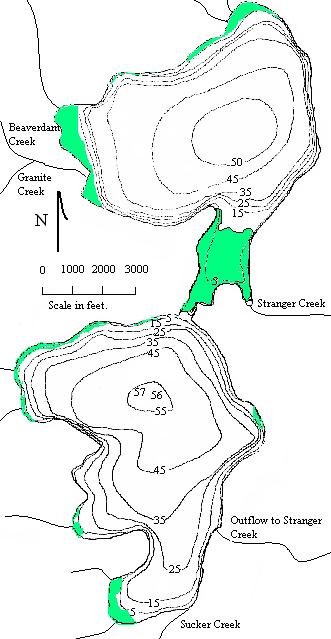
Map illustrates lake depths in feet and
aquatic plant distribution in green.
Aquatic plants
A native aquatic plant called watershield
(Brasenia schreberi) dominates the plant
community in Twin Lakes. Watershield in North
Twin Lake can cover approximately 68 acres and
around 19 acres in South Twin Lake. These plants
provide important habitat for fish and wildlife,
reduce bank erosion caused by waves, and uptake
deleterious nutrients. Bass predation on shiners
and fish distribution can be impacted by dense
watershield beds like those observed in North
Twin Lake.
Aerial view of watershield development in North
Twin Lake.
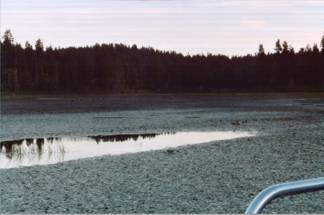
View of watershield from channel between North
and South Twin Lakes.
Fish Community
Brook Trout Salvelinus
fontinalis: Are nonnative to Twin
Lakes. The native range of brook trout is the
eastern region of the United States and Canada
south through the Appalacian Mountains, Great
Lakes and parts of the Missouri River System.
Brook Trout are fall spawners when temperatures
and daylight begin to decline. The tribe stocks
both lakes annually with brook trout. There is
also a naturalized reproducing population of
brook trout in both lakes.
Our samples indicate that brook trout represent
12-15% of the total trout population in both
lakes. Approximately 83-88% of our samples in
both lakes were wild fish. The mean length for
brook trout in our sample was 13.4 inches with a
range of 9.05-18.1 inches. Although feeding
behavior varies throughout the year in Twin Lakes
brook trout feed primarily on fantom midges,
scuds, and zooplankton.
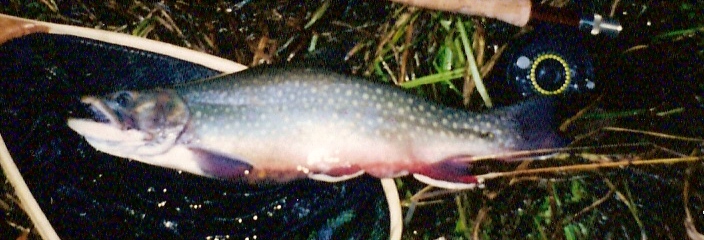
Male brook trout
Rainbow trout Oncorhynchus
mykiss: Rainbow trout are native to
the west coast of the United States north through
Canada and into Southern Alaska. Their range also
extends as far south as northern Mexico and into
parts of eastern Russia such as the Kamchatka
Penninsula. Rainbow trout are spring spawners as
water temperatures and daylight begin to
increase.
Historically, a redband rainbow trout form may
have existed in Twin Lakes but is now displaced
by hatchery coastal rainbow trout. The tribe is
considering stocking the lake in the future with
redbands that may survive and grow better in Twin
Lakes than the present coastal form.
Our samples indicate that rainbow trout represent
85-88% of the total trout population. Our samples
also indicate that approximately 1-4% are
naturally reproducing fish. The mean length of
rainbow trout in our sample is 12.36 inches with
a range of 8.66-18.5 inches. Although feeding
behavior varies throughout the year in Twin Lakes
the rainbow trout feed primarily on fantom
midges, zooplankton, and scuds. We occasionally
sampled small shiners from larger trout stomachs.
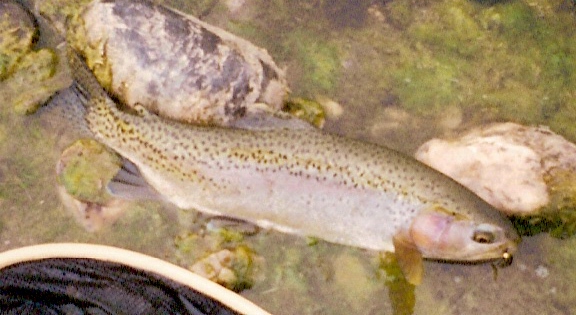
Rainbow trout
Largemouth Bass Micropterus
salmoides: Are nonnative to Twin
Lakes. Largemouth bass are native to the Missouri
and Mississippi River Drainages, the Great Lake
Region, south through Georgia and Florida and
southeastern Canada. Largemouth bass are spring
spawners. Largemouth bass were introduced
illegally into Twin Lakes, most likely in the
early 1980's.
Largemouth bass are well established in Twin
Lakes and inhabit the weed beds and adjacent
shoreline habitats in large number. In Twin
Lakes, bass over 10 inches feed primarily on
golden shiners and crawfish. Smaller bass eat
primarily aquatic insects and smaller
crustaceans.
The mean length of largemouth bass sampled from
Twin Lakes was 7.25 inches with a range of
2.4-20.67 inches.
This bass was sampled and released in North
Twin Lake.

This bass was sampled and released in South
Twin Lake.
Golden Shiners Notemigonus
crysoleucas: Are nonnative to
Twin Lakes. Their native range is very similar
to that of the largemouth bass. Golden shiners
spawn in the spring but under good conditions
can spawn into late summer. Golden shiners are
a natural prey organism for bass in much of
their native range. Golden shiners were
introduced illegally, most likely in the early
1990's. Bass appear to be limiting golden
shiner numbers in Twin Lakes.
Golden shiners are omnivorous, feeding on both
plant and animal tissue. In Twin Lakes,
approximately 50% of their diet is algae and
plant debris. The other 50% of their diet
consists of scuds, midges, snails and clams,
mayfly and caddisfly, and zooplankton.
Golden shiners grow quikly and can tolerate a
wide range of water temperatures and dissolved
oxygen levels. They are also very prolific and
can deposit up to 250,000 eggs in one season.
Depending on temperatures the embryos can hatch
in 5-7 days. Without a predator to feed on them
they can often overpopulate a water body and
cause reduced growth rates in other species such
as trout.
Mean golden shiner length in our Twin Lakes
samples is 6.14 inches with a range of 1-9.25
inches.

Golden shiner sampled from Twin Lakes. The
large circle shows a deeply depressed lateral
line distinctive of golden shiners. The small
circle shows sickle shape anal fin also
indicitive of golden shiners.
The circle shows a scaleless keel which is a
key identifier of golden shiners.
Graph represents the estimated number of golden
shiners consumed by largemouth bass over the 90
day sampling period. The x-axis represents the
size classes of largemouth bass sampled. Values
are an average for 2004 and 2005 estimates.
Bridgelip sucker Catostomus
columbianus: Are native to Twin
Lakes. Their native range is the Columbia and
Fraser River systems. Bridgelip suckers are
common throughout the Columbia River ecosystem.
They generally spawn from April to June.
Juveniles feed on zooplankton and aquatic
insects. As they mature, their mouth parts
develop into a sucker and begin to feed
primarily on detritus, algae, and
crustacean/insects on the lake bottom.
Bridgelip suckers can play an important role of
nutrient recycling of dead and dieing material
in an aquatic ecosystem. Only one bridgelip
sucker was sampled from Twin Lakes.

Bridgelip sucker. Photo from Living Gardens.
Redside shiner Richardsonius
balteatus:
Are native to Twin Lakes. Their native range
extends throughout the Pacific Northwest. Their
range also extends into parts of Utah, Nevada,
Wyoming, and Montana. Redside shiners do well in
both streams and lakes but prefer calm waters
with associated weed beds. Redside shiners also
tend to move in schools. They can be a good
forage fish for large predatory fish. Redside
shiners feed on zooplankton and aquatic insects.
In Twin Lakes only a few showed up in our
samples. Their populations may be depressed by
the presence of golden shiners.

Redside shiner. Photo courtesy the State of
Utah Natural Resources Division of Wildlife
Resources.
Parasites often found on trout in Twin
Lakes.
A copepod parasite called salmoncula occurs
naturally in Twin Lakes. It appears the most
frequently on hatchery fish released within the
year. These newly released fish are lessed able
to withstand the parasite. The wild trout and
holdover fish are less affected because they have
adapted to the parasite. The parasite becomes
most active in July-September when surface
temperatures increase. With high temperatures
trout often become stressed and are less able to
fight off the parasite.
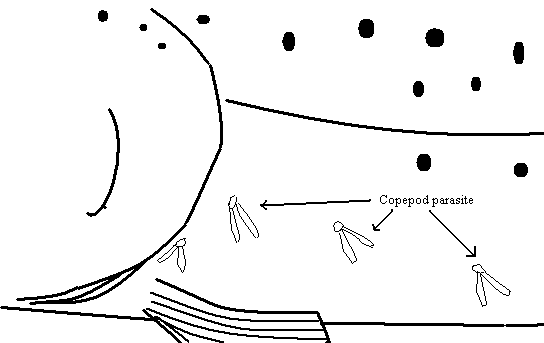
Diagram of trout with several copepod
parasites.
Much of the general fish identification, habitat,
range, and life history traits were found in the
book "Inland Fishes of Washington." Reference
information is found below.
Wydoski, R.S., and R.R. Whitney. 2003. Inland
fishes of Washington. American Fisheries
Society, Bethesda, Maryland.
|



